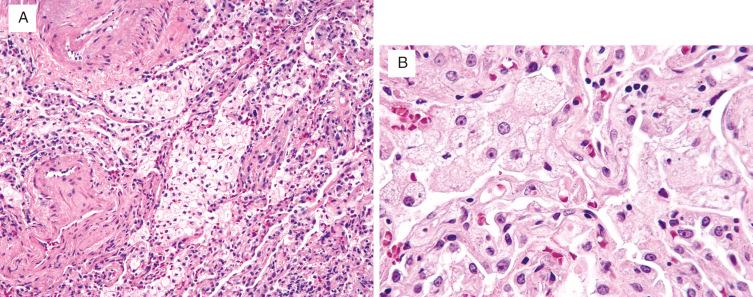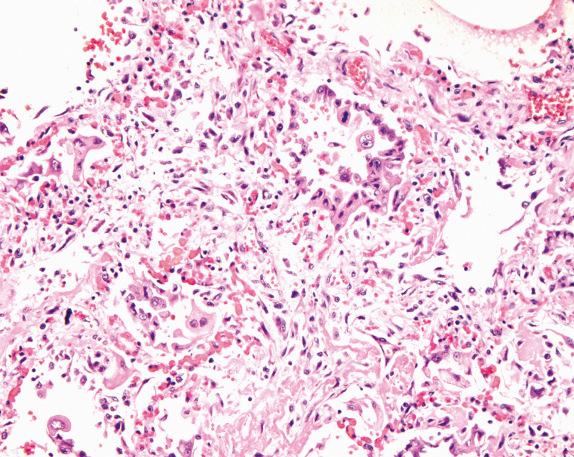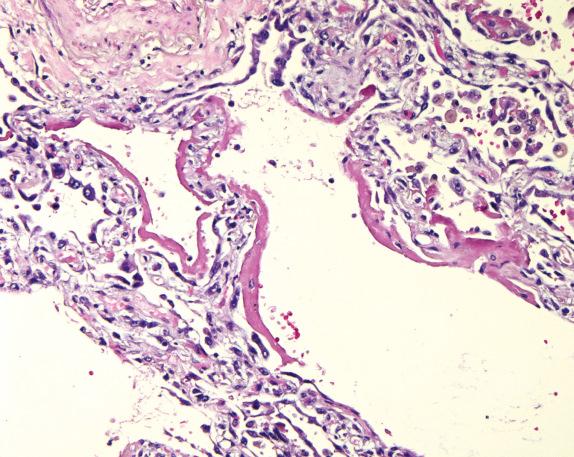Physical Address
304 North Cardinal St.
Dorchester Center, MA 02124
Drug-induced lung injury is common and can be induced by a wide variety of drugs used for treatment of many different clinical conditions. More than 600 prescribed medications have been reported to cause drug-induced pulmonary toxicity. Adverse drug reactions have been estimated to occur in approximately 5% of all patients receiving any drug and are responsible for up to 0.03% of all hospital deaths. Although less frequent than liver or cutaneous manifestations, pulmonary involvement deserves special attention due to the potential for severe disease presentations. Fortunately, most outcomes are favorable with withdrawal of the offending agent and, in some cases, immunosuppressive therapy.
In recent years, much attention has been directed to identifying potentially harmful drugs and understanding the complex and varied mechanisms of injury. Some reports published in the 1960s included fewer than 20 drugs that were believed to cause lung injury. This number has expanded greatly since that time, and drugs that have been implicated span virtually all areas of medicine. The drugs associated with the highest rate of occurrence of adverse pulmonary reactions include the chemotherapeutic agents nitrofurantoin, and amiodarone, but essentially any drug can be a potential cause of an idiosyncratic reaction.
Establishing a definite linkage between a potential etiologic agent and the lung injury is not always achievable, so in some cases a particular agent may be considered a “probable” or “possible” cause of the lung injury encountered. Evaluation of patients for these complications should include a comprehensive review of all therapeutic agents being administered, their dosages, and the temporal relationships between initiation and cessation of the agents and the evolution of the patient’s symptomatology. In general, evidence of a temporal association between drug usage and development of symptoms, and conversely, drug cessation and improvement in symptoms supports linking a specific agent to a patient’s respiratory disease.
For many agents, considerable data exist regarding the manifestations of drug-related lung injury. Correlation of an individual’s clinical and radiologic picture with this literature for potentially causative agents is important. Coexisting medical conditions can affect patient presentation, as can simultaneous treatment with multiple agents. For immunocompromised patients, opportunistic infections are usually considered in the differential diagnosis and should be carefully evaluated for before the lung injury is attributed solely to an adverse drug effect. Although the diagnosis of drug-related pulmonary injury is often made clinically, lung biopsy can be helpful for establishing that compatible (although usually not specific) histologic findings are evident and excluding the presence of infection, recurrent disease, or another type of lung disease altogether.
For many agents, risk factors for pulmonary toxicity are not well understood. Although drug dosage may be important for some drugs (amiodarone, nitrosoureas), it may not always be predictive even for these agents; amiodarone has been reported to induce drug reactions in what is considered to be a safe, low dosage of less than 200 mg. Other risk factors that apply to individual agents may include advanced age, renal dysfunction causing decreased drug elimination and elevated drug levels, rapid infusion with resultant elevated blood levels, and concurrent administration of an agent (for example, a chemotherapeutic drug) with potential pulmonary toxicity to a patient receiving high concentrations of oxygen or radiation therapy. Mechanisms of injury also vary for different agents. Cellular toxicity is caused by some agents or their metabolites, such as the chemotherapeutic agents, but host immune and allergic reactions play important roles in the genesis of the lung injury caused by many agents.
If the probable offending agent can be discontinued without significant adverse effects, treatment of the putative drug reaction will usually begin with withdrawal of the agent. For patients with mild reactions of a relatively short duration, this may be sufficient treatment. However, for some reactions that do not resolve with drug cessation, corticosteroids may also be administered.
Although the list of agents linked to pulmonary reactions is extensive, this chapter will focus on a number of the more common agents. A more comprehensive list of drugs, the types of pulmonary reactions they induce, and an extensive catalog of reference material is available online at www.pneumotox.com . Many of the histopathologic patterns of lung injury associated with drug reactions are listed in Table 19.1 and described elsewhere in this book.
| Primarily conducting airway–centered injury patterns | Asthma |
| Thermal or chemical airway injury | |
| Bronchiectasis | |
| Bronchial stricture | |
| Primarily distal parenchymal injury patterns | Pulmonary edema |
| Diffuse alveolar damage | |
| Acute fibrinous and organizing pneumonia | |
| Hypersensitivity pneumonia | |
| Interstitial pneumonia patterns—nonspecific, usual, lymphoid | |
| Organizing pneumonia | |
| Bronchiolitis obliterans | |
| Alveolar collections of foamy histiocytes | |
| Eosinophilic pneumonia | |
| Alveolar hemorrhage | |
| Panacinar emphysema and bullous lung disease | |
| Alveolar proteinosis-like exudates | |
| Lipoid pneumonia | |
| Obliterative pulmonary fibrosis | |
| Pleuroparenchymal fibroelastosis | |
| Primarily vascular injury patterns | Pulmonary arterial hypertension |
| Pulmonary venoocclusive disease | |
| Small vessel vasculitis with alveolar hemorrhage | |
| Thrombotic and embolic phenomena | |
| Foreign-body giant cell reaction to intravenously administered drug preparations |
∗ Detailed histopathologic descriptions of these injury patterns are found in the sections of the book devoted to these patterns. Combinations of these patterns can also occur.
Incidence is less than 5% of the treated population
Toxicity appears to be more common with higher dosages, but can also develop in patients treated with low dosages; other risk factors include longer duration of treatment and increased age
Men appear to be more frequently affected than women
Insidious onset of dyspnea, dry cough, chest pain, and malaise is usual; fever can also occur
Onset is usually in the first year after beginning the medication but can occur later, and rare cases develop after the drug has been discontinued
Variably severe interstitial and/or alveolar infiltrates, patchy or diffuse, involving one or both lungs
Masslike opacities, pleural thickening, and pleural effusions can also be observed
Treatment usually involves discontinuation of the drug, and corticosteroids can be administered for severe cases
Clinical and radiologic improvement can take weeks or months, due to the slow clearance of the drug from tissues
Resolution occurs in most patients; pulmonary fibrosis in a small number
Mortality rate is likely to be much lower than the reported 10%
Numerous lipid-laden macrophages in alveolar spaces
Pneumocytes, interstitial cells, and endothelial cells may demonstrate cytoplasmic lipid vacuoles
Variably intense lymphocytic interstitial infiltrate
Variable degrees of interstitial edema or fibrosis with type 2 pneumocyte proliferation
Other patterns may include organizing pneumonia and diffuse alveolar damage
Foamy macrophages
Lymphocytosis with increased CD8-positive lymphocytes and/or neutrophilia
Membrane-bound cytoplasmic inclusions composed of densely packed whorls of thin lamellae, similar to surfactant lamellar bodies, in macrophages, endothelial cells, interstitial cells, and pneumocytes
Infections, especially those that can cause an interstitial pneumonia (viruses, Mycoplasma, Chlamydia, fungi) or macrophage infiltrates (mycobacteria, fungi, Whipple disease, malakoplakia)
Lipoid pneumonia due to aspiration (exogenous) or airway obstruction (endogenous)
Storage diseases
Erdheim-Chester disease
Other causes of diffuse alveolar damage
Amiodarone, an amphiphilic benzofuran derivative, is the most commonly used antiarrhythmic drug used to treat supraventricular and ventricular arrhythmias. Unfortunately, however, toxic effects on multiple organs, including lung, skin, thyroid, eye, and liver, have been associated with administration of this drug. Amiodarone pulmonary toxicity (APT) produces a number of characteristic pathologic changes in the lung that can result in respiratory insufficiency of variable severity or even, uncommonly, in death. Amiodarone and its metabolite, desethylamiodarone, accumulate in tissues, including the lung, and are retained intracellularly in lysosomes, where they interfere with turnover of endogenous phospholipids. The accumulation of lipid imparts a foamy appearance to the cytoplasm of these cells, which is particularly conspicuous in alveolar macrophages of treated patients.
The cumulative prevalence of APT has been estimated between 1% and 15% of the treated population, and there appears to be some degree of linkage between higher dosages, longer durations of treatment, and an increased risk of developing APT. Nonetheless, patients receiving lower dosages can still develop APT, albeit at a lower rate than those treated with higher dosages. More recent trials utilizing lower maintenance doses yielded incidence rates of 5% or less, and a metaanalysis found a risk of APT of approximately 2%. Men are affected more frequently than women, and the likelihood of APT appears to increase with age.
A typical presentation of APT includes an insidious onset of dyspnea, dry cough, chest pain, and malaise. Fever may also be present and raise a concern about the existence of an infectious pneumonia. Onset can occur at any point between a few days after administration of the loading dose of amiodarone to more than a decade after treatment was started. Development after cessation of therapy can also occur, but is rare. Most reactions develop, however, during the first year after initiation of drug therapy. Radiologic features include alveolar, interstitial, or mixed alveolar-interstitial opacities, and an asymmetric distribution of lung involvement is common. Subpleural masses are seen in a minority of patients, and pleural thickening or effusion may also be evident. Pulmonary function testing typically reveals a restrictive pattern and a decrease in the carbon monoxide diffusing capacity. The clinical differential diagnosis may include a worsening of heart failure with cardiogenic pulmonary edema, infection, pulmonary infarcts, eosinophilic pneumonia, other drug reactions, aspiration, lymphoma, and bronchioloalveolar carcinoma. If other etiologies for the lung disease can be eliminated and APT is judged to be the most likely diagnosis, treatment usually involves withdrawal of the drug, provided that the drug can be discontinued. Clearance from tissues, however, is slow, and visible clinical improvement may take weeks or months. Corticosteroid therapy can also be administered in severe cases. This approach will produce resolution in most patients, although a small number of patients develop pulmonary fibrosis. Although the mortality rate for APT has been reported to approach 10% in patients with the condition, this may reflect reporting of the more severely affected patients, and the actual rate is likely to be much lower.
Lung biopsy is usually not obtained unless the diagnosis of APT is uncertain (an infection is also considered or the patient does not show improvement by 1–2 months after discontinuation of amiodarone and institution of corticosteroid therapy). Histologic evaluation can determine whether compatible features are present and whether another process (especially an infection or heart failure) exists or coexists with APT. Biopsy characteristically shows features of a chronic interstitial pneumonia accompanied by lipid-laden macrophages and lipid inclusions in other cell types ( Fig. 19.1 ). The lipid-laden macrophages are usually conspicuous in alveolar spaces, and cytoplasmic lipid vacuoles can also be seen in pneumocytes, interstitial cells, and endothelial cells. Variable numbers of interstitial mononuclear inflammatory cells, primarily lymphocytes, are present, and interstitial edema or fibrosis with type 2 pneumocyte proliferation may be evident. Organizing pneumonia, characterized by myxoid fibroblastic tissue in distal airways and alveoli, is another frequent finding, and the severity and extensiveness of interstitial and alveolar fibrosis are variable.

In some patients presenting with features of the acute respiratory distress syndrome, a complication occurring almost entirely in patients receiving amiodarone after thoracic surgery, a histologic picture of diffuse alveolar damage can be seen ( Chapter 9 ). Alveolar hemorrhage is another less common feature.
Bronchoalveolar lavage fluid typically shows foamy macrophages. These cells reflect drug use, but are not specific for drug toxicity, because they are seen in settings with and without clinical and radiologic evidence of APT. Lymphocytosis, with increased CD8-positive lymphocytes, has been reported, as have increased neutrophils.
Ultrastructural analysis can be performed on tissue or cells from the bronchoalveolar lavage fluid and reveals membrane-bound cytoplasmic inclusions composed of densely packed whorls of thin lamellae, similar to surfactant lamellar bodies in macrophages, endothelial cells, interstitial cells, and pneumocytes.
A large number of chemotherapeutic agents are associated with pulmonary injury
Pulmonary toxicity is estimated to develop in less than 10% of treated patients overall, and the frequency varies with the individual agent
Risk factors for lung injury also vary with the individual agents and may include drug dosage, advanced age, concurrent thoracic radiation therapy or treatment with a second chemotherapeutic agent, use of high inspired oxygen concentrations, and other underlying diseases
Acute, subacute, and chronic presentations have been described
Radiographic changes depend on the specific pattern and distribution of pulmonary pathology represented, but diffuse interstitial infiltrates or a mixed interstitial-alveolar pattern are common
Diffuse alveolar damage with variable degrees of pneumocyte atypia
Organizing pneumonia
Eosinophilic pneumonia
Nonspecific or usual interstitial pneumonia
Hypersensitivity pneumonia
Treatment usually involves discontinuation of the drug, if feasible, and corticosteroids are also commonly administered
Mortality rate varies with the agent and the pattern of injury
In survivors, the degree of respiratory compromise usually depends on the extent of pulmonary fibrosis
Many conventional chemotherapeutic agents have been associated with lung injury. Bleomycin, methotrexate, cyclophosphamide, busulfan, and a variety of other agents are recognized for their roles in triggering lung injury, which can range from mild to severe and potentially fatal. Pulmonary toxicity is estimated to develop in less than 10% of patients receiving chemotherapeutic agents, however. Usual symptoms include dyspnea, cough, and often fever. Although acute presentations can occur, symptoms more frequently begin weeks to as long as years after initiation of the agent(s). Radiologic changes commonly include diffuse interstitial infiltrates or a mixed interstitial-alveolar pattern, and lung function studies typically show reduction in diffusing capacity. Naturally, these changes depend on the specific pattern of lung injury and its severity. More common histopathologic patterns associated with chemotherapeutic agents are listed in the accompanying Fact Sheet. One less common pattern that has received more recognition recently because of its occurrence as an idiopathic pattern is pleuroparenchymal fibroelastosis, whose histopathologic features are discussed elsewhere in this book. Finally, in patients receiving chemotherapeutic agents, the differential diagnosis for the pulmonary process also often includes opportunistic and other infections, so appropriate organism stains, cultures, and clinical laboratory and molecular pathology testing should be performed as part of patient evaluation.
Among the chemotherapeutic agents, bleomycin is the most prevalent cause of pulmonary disease. It is an antibiotic agent that produces cytotoxicity by induction of free radicals, which causes breaks in DNA, leading to cell death. Its inactivating enzyme, bleomycin hydrolase, is relatively deficient in the lungs and skin, which predisposes to toxic manifestations predominantly in these sites. Immune and inflammatory cells are key participants in the pathophysiology of the injury, with cytokines, free radicals, and growth factors as mediators. The best recognized risk factors for pulmonary toxicity include cumulative dose, reduced renal function, and advanced age. Up to 46% of patients treated with bleomycin-containing chemotherapy have been reported to develop pulmonary toxicity, and the mortality rate appears to fall between 1% and 3% of all patients treated with bleomycin. Treatment usually includes discontinuation of bleomycin and administration of corticosteroids.
Interstitial pneumonia is the most common manifestation of pulmonary toxicity. The pathologic features reflect a progression of cellular injury, with features of diffuse alveolar damage. Early changes include endothelial injury, interstitial edema, and pneumocyte necrosis. This is followed by proliferation of type 2 pneumocytes, which may show marked atypia, and often prominent metaplastic epithelial changes ( Fig. 19.2 ). Abundant macrophages may be seen in alveolar spaces, and there is usually a mild mixed inflammatory interstitial infiltrate. Fibroblast proliferation occurs, with resultant interstitial and alveolar fibrosis. The advanced process can resemble usual interstitial pneumonia. Other histologic presentations can include eosinophilic pneumonia and organizing pneumonia. In some patients, lesions can have a more nodular radiographic appearance, which may raise the question of tumor metastasis.

Cyclophosphamide, an alkylating agent, is a cornerstone of many chemotherapeutic regimens for treatment of a wide variety of malignancies and vasculitides. The frequency of clinically significant lung injury is difficult to estimate because other potential causes of lung injury frequently exist in patients with potential cyclophosphamide toxicity, but appears to be less than 1%. Both early- and late-onset pneumonitis have been described in association with this agent. With early-onset pneumonitis, symptoms of cough, dyspnea, and fever develop within 1 to 6 months after drug exposure. Patients frequently improve with discontinuation of the drug and use of corticosteroids. In contrast, late-onset pneumonitis and fibrosis develop after prolonged treatment with cyclophosphamide over months to years and can occur even after discontinuation of the drug. Insidious onset of cough and dyspnea with radiographic evidence of pleural thickening and restrictive changes on pulmonary function testing are characteristic. Progressive respiratory failure may lead to death in patients with this form of drug toxicity. Although clear-cut risk factors have not been identified, men may be at higher risk than women for this complication. Histologic manifestations that have been linked to cyclophosphamide include diffuse alveolar damage ( Fig. 19.3 ), organizing pneumonia, alveolar hemorrhage, and other patterns of injury. Pneumocyte atypia may be present.

Become a Clinical Tree membership for Full access and enjoy Unlimited articles
If you are a member. Log in here